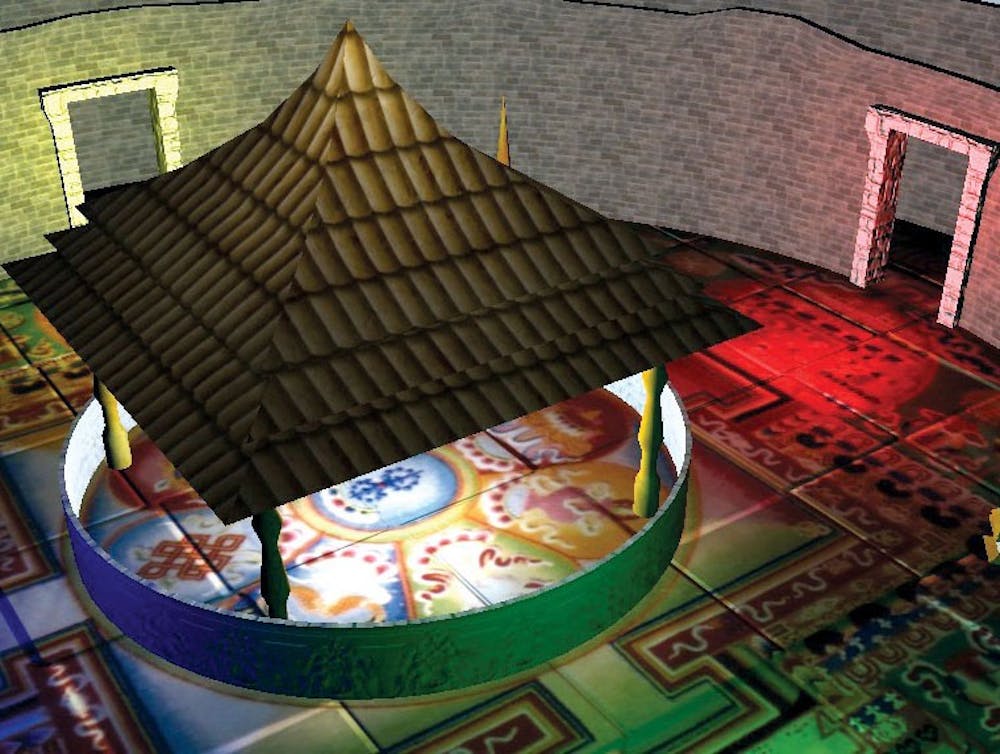
A screenshot of the virtual reality mandala created by AIMS students working on projects to help preserve Tibetan culture. (ERIC HODGSON | Miami University )
Google and Miami University are teaming up to help digitally preserve the identity of Tibet.
Miami is working with Tibet to help complete three technological goals they have identified would help carry on their culture, despite the lack of an actual country and land to call home.
Armstrong Interactive Media Studies (AIMS) has three projects they have been working on for nearly a year, according to Glenn Platt, co-director of AIMS.
After visiting Tibet last year, Platt said he was touched by the lack of resources the Tibetans had to save the history, values and language, he knew that Miami could help fix the problem that had plagued their people.
"When you go there, you can't help but be moved by their plight," Platt said. "The history of the Tibetan people, the struggles that they're wrestling with to preserve their culture are heartbreaking."
Platt said with the help of students Miami has scanned in national archives and texts that will eventually be accessible on Google.com.
Miami's main purpose in the project was to get Tibet set up with ways to scan in the documents and substantiate a relationship with Google.
"Our students came up with the brilliant idea of seeing if Google could get involved with the pro ect," Platt said. "We have essentially brokered this relationship with Google and the Tibetan government to make this go faster and better."
Student project manager Noah Bornstein said eventually the Tibetan records would be recorded as Google Books.
"I'm acting as a liaison between the Library of Tibetan Works and Google," Bornstein said. "All of these documents they're currently scanning will be online for World Wide Web access."
Enjoy what you're reading?
Signup for our newsletter
But don't expect to see Tibetan archives popping up on Google.com anytime soon — the project is expected to take decades.
The Tibetans are working with one scanner and their thousands of ancient archived texts are unusually shaped, which makes it difficult to scan, Platt said.
"It's going to take them literally 30 years to scan this all in — it's page by page," Platt said.
The second project Platt and his team of students are working on will be more short-term. It will help project the Tibetan language across the world with the help of the Internet.
"They're really the same project," Platt said. "The theme in all of these projects is how can the Tibetan culture language and philosophy be transmitted throughout the world now that Tibetans are sort of spreading out across the world."
To help maintain the language of Tibetans across the world, students are working on an online learning tool.
The online language guides will hold the context of a book and will be done in approximately a year, according to Platt.
While the Dalai Lama will be updated on all of these projects, there is one thing he will physically test out during his stay here — a virtual mandala.
The mandala is used in both the Hindu and Buddhist religions. For those who meditate in these religions, it is used as a "map," which during meditation people are guided through and navigate.
Through the use of a brain scanner, AIMS has developed a way in which the user can virtually navigate through a mandala.
"Instead of asking people to imagine themselves between these maps, what if we built this mandala that people can move through physically?" Platt said of his initial thoughts for the project.
Platt said those who wish to virtually meditate can do so by placing a system controller that measures electric activity on their head.
The controller is able to read electric activity after calibration and picks up on certain thoughts that a user may have, Platt said.
The project is still in the working stages, but will be over halfway finished during the Dalai Lama's stay, according to Platt.
Although the project may sound like something out of a science fiction film, Platt said it is an integral part of a Miami education.
"This fits perfectly in with the mission of AIMS and Miami, we're all about how technology can help and enable the everyday things in the world," Platt said. "It really speaks to the sweet spot of what Miami is about."




